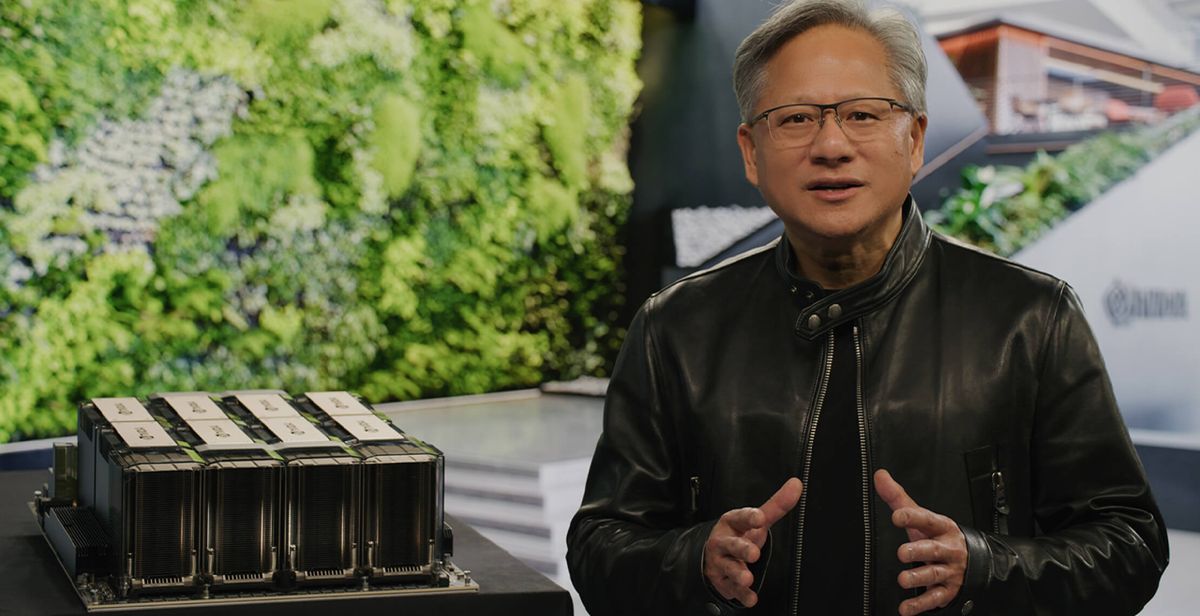
NVIDIA's CEO, Jensen Huang, took to the stage at the GPU Technology Conference (GTC) 2023 to unveil a series of groundbreaking advancements and partnerships in the world of AI, cloud computing, and healthcare technology. These developments have the potential to revolutionize industries and drive AI innovation forward.
At the core of NVIDIA's announcements is the launch of the Hopper GPU architecture, named after computer science pioneer Grace Hopper. This new architecture is designed to accelerate AI training and inference, providing a significant leap in performance and energy efficiency.
Huang showcased the power of the Hopper architecture in the NVIDIA DGX H100, a blueprint for AI infrastructure that features eight NVIDIA H100 GPUs working in unison. Major cloud providers such as Oracle, Amazon Web Services, and Microsoft Azure have already announced limited availability and private previews of instances featuring H100 GPUs.
Notably, Meta has deployed its H100-powered Grand Teton AI supercomputer for internal use by its AI production and research teams. OpenAI will also leverage H100s on its Azure supercomputer to fuel ongoing AI research.
To extend DGX capabilities to startups and enterprises, Huang announced NVIDIA DGX Cloud, a partnership with Microsoft Azure, Google Cloud, and Oracle Cloud Infrastructure. This initiative aims to bring NVIDIA DGX AI supercomputers to every company, right from a browser.
One of the event's highlights was the introduction of NVIDIA AI Foundations, a family of cloud services designed to help customers build and operate custom Large Language Models (LLMs) and generative AI for domain-specific tasks. Notable partners include Adobe, Getty Images, and Shutterstock, who are collaborating with NVIDIA to create next-generation AI capabilities for their respective industries.
- Adobe is partnering with NVIDIA to build a set of next-generation AI capabilities for the future of creativity.
- Getty Images is collaborating with NVIDIA to train responsible generative text-to-image and text-to-video foundation models.
- Shutterstock is working with NVIDIA to train a generative text-to-3D foundation model to simplify the creation of detailed 3D assets.
In the medical field, NVIDIA announced partnerships with Amgen, Alchemab Therapeutics, AstraZeneca, Evozyne, Innophore, and Insilico, all early access users of the company's BioNeMo service. This offering aims to accelerate drug discovery by helping researchers create, fine-tune, and serve custom models with proprietary data.
Furthering its impact on healthcare, NVIDIA is collaborating with Medtronic, the world's largest healthcare technology provider, to develop an AI platform for software-defined medical devices. The partnership will create a common platform for various Medtronic systems, including surgical navigation and robotic-assisted surgery.
To help companies deploy rapidly emerging generative AI models, NVIDIA announced a series of inference platforms, including the NVIDIA L4 Tensor Core GPU and the NVIDIA H100 NVL GPU. These platforms cater to AI video, image generation, LLM deployment, and recommender inference, with Google Cloud being the first provider to offer the L4 platform.

Image credit: NVIDIA
NVIDIA is also teaming up with Microsoft to bring NVIDIA Omniverse Cloud, a fully managed cloud service, to a massive audience. This partnership will extend the powerful simulation and collaboration capabilities of Omniverse to hundreds of millions of Microsoft 365 and Azure users.
In the semiconductor industry, Huang announced NVIDIA cuLitho, a software library for computational lithography that has the potential to revolutionize chip design and manufacturing. Key players like ASML, TSMC, and Synopsys are integrating NVIDIA cuLitho into their software, manufacturing processes, and systems. ASML, a leading chip-making equipment provider, is working closely with NVIDIA to integrate GPU support into all their computational lithography software products. Huang emphasized that cuLitho will enable the industry to push beyond the 2nm barrier.
Several major companies have already embraced NVIDIA's vision and technologies. AT&T uses NVIDIA AI to process data more efficiently and is testing Omniverse ACE and the Tokkio AI avatar workflow to develop virtual assistants for customer service and employee help desks. Other organizations, such as American Express, the U.S. Postal Service, Microsoft Office and Teams, and Amazon, are among the 40,000 customers utilizing the high-performance NVIDIA TensorRT inference optimizer and runtime, as well as NVIDIA Triton, a multi-framework data center inference serving software.
Uber leverages Triton to serve hundreds of thousands of ETA predictions per second, while Roblox, with over 60 million daily users, utilizes the platform for game recommendations, avatar building, and content moderation. Tech giants Microsoft, Tencent, and Baidu have all adopted NVIDIA CV-CUDA for AI computer vision, delivering four times the cost and energy savings.
In his closing remarks, Huang thanked NVIDIA's partners, researchers, scientists, and employees for their contributions. He reported that the global NVIDIA ecosystem now spans four million developers, 40,000 companies, and 14,000 startups in NVIDIA Inception. Jensen Huang said, "Together, we are helping the world do the impossible."
By unveiling cutting-edge AI technologies, forming strategic partnerships, and enabling a wide range of industries, NVIDIA is shaping the future of AI, cloud computing, and healthcare technology. The announcements at GTC 2023 solidify NVIDIA's position as a driving force in the tech world, pushing the boundaries of what's possible.
Here is a video to the full 78-minute keynote.

